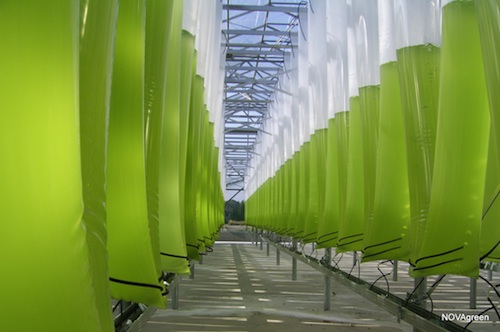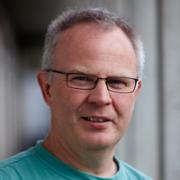Pioneering Venture Into Producing Cancer Drugs in Solar Driven Bioreactors

Scientists will use synthetic biology to create sustainable production of medicinal and other high-value compounds in so-called photo-bioreactors. This will be done in a consortium with both Danish and European companies, which has just been granted 20,6 mill. DKK in support from the Danish Council for Strategic Research. The project will bring together some of the world’s foremost synthetic biologists, among them Jay Keasling of UC Berkeley.
Read Ingeniøren's report about this project on their website (in Danish)
”We want to create the foundations for a completely novel production method for high-value products, which can be used in the pharmaceutical industry,” says professor Poul Erik Jensen (photo below) from Department of Plant and Environmental Sciences and Center for Synthetic Biology at University of Copenhagen.
He is heading the project, which has just been granted 20,6 mio DKK from the Danish Council for Strategic Research and which will use synthetic biology to develop the organisms to produce large quantities of the valuable compounds.
“The production itself will take place in contained photo-bioreactors with e.g. moss or cyanobacteria, which have been developed to channel sunlight directly into the production of the desired products. This is somewhat similar to the production of insulin. But we add to it the extra sustainable aspects, that it is sunlight driving the process,” he recounts.
Novel sustainable production with full-chain focus
The idea is based on groundbreaking results: By moving the enzymes responsible for the synthesis of the desired compounds into the sunlight harvesting chloroplasts, it is shown that the energy from the photosynthesis is directly driving the production process, while the products accumulate in the chloroplasts. This concept can be used to produce e.g. complex terpenoids, that have applications as cancer drugs among other things.
 ”We now take this a step further by focusing on the production of the complex bioactiveterpenoids, that are hard – or completely impossible – to produce by chemical synthesis, which is expensive and often environmentally harmful to boot,” says Poul Erik Jensen (photo). He is working on the project in close collaboration with the world leading synthetic biologist Jay Keasling of UC Berkeley (USA) and membrane protein experts from Warwick University (UK).
”We now take this a step further by focusing on the production of the complex bioactiveterpenoids, that are hard – or completely impossible – to produce by chemical synthesis, which is expensive and often environmentally harmful to boot,” says Poul Erik Jensen (photo). He is working on the project in close collaboration with the world leading synthetic biologist Jay Keasling of UC Berkeley (USA) and membrane protein experts from Warwick University (UK).
Dedicated businesses are responsible for the near-market part of the project including tests of the organisms under production-like conditions and of the products themselves. These companies include Evolva Biotech, AgroTech, NOVAgreen GmbH, and LEO Pharma who are all linked to this vital part of the project.
The Executive of NOVAgreen, Dr. Theodor Fahrendorf comments on the collaboration: ”We need to free ourselves from fossil fuels by developing an efficient, sustainable knowledge-based economy for the future. We wish to aid this transition with our expertise in running these sorts of tests.”
Combined, these efforts will result in the development of new, CO2-neutral production platforms and state-of-the-art photo-bioreactor technology in Denmark.
Facts:
1: How a photo-bioreactor works
A photo-bioreactor is a bioreactor, in which sunlight is used as an energy source for growing photosynthetic organisms such as cyanobacteria, algae, mosses, or plant cells. The term photo-bioreactor is normally used for closed systems that are kept isolated from the surrounding environment, without any exchange of e.g. gasses nor danger of contamination from the surroundings.
For this particular project the cyanobacteria or moss cells are placed in solution within these reactors. The cells are developed in such a way, that the enzymes that produce the high-value compounds have been transferred to the membrane of the chloroplast. The desired products will thus accumulate in the chloroplasts, where they can be harvested from the cells.
2: Why we need terpenoids
Many of the active compounds used in medical drugs today are terpenoids that have been orginally discovered in and extracted from medicinal plants. The plants often use terpenoids as biochemical defenses, but they exist in very small quantities in plant cells, as they require many resources for the plant to produce them. E.g. the cancer-treatment drug taxol is a terpenoid.
3: The Consortium
The project consortium includes researchers from University of Copenhagen, University of California Berkeley (e.g. Jay Keasling), and University of Warwick in the UK as well as the private corporations Evolva Biotech A/S, AgroTech A/S, Novagreen GmbH and LEO Pharma A/S.
4: The Grant
The Danish Council for Strategic Research supports the project with 20,6 million DKK.
Further info:
Read about Professor Poul Erik Jensen's research here:
https://synbio.ku.dk/research/researcher_profiles/poul_erik_jensen/
Read about some of the members of the consortium here:
http://cheme.berkeley.edu/faculty/keasling/
http://www.evolva.com/
http://agrotech.dk/en
http://www.novagreen-microalgae.com/
http://leo.dk/
Read about the Danish Council for Strategic Research here:
http://fivu.dk/en/research-and-innovation/councils-and-commissions/the-danish-council-for-strategic-research/
